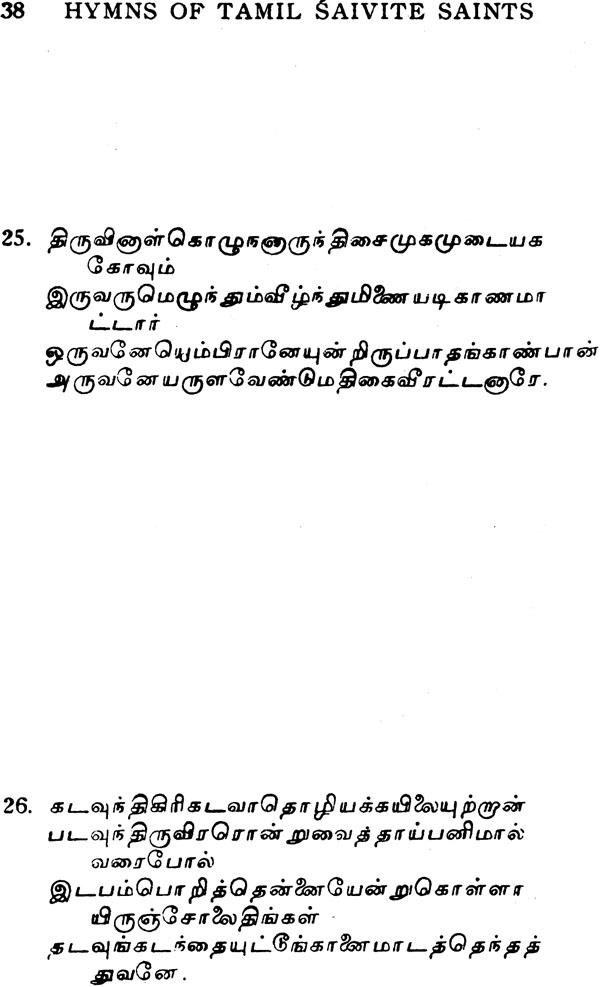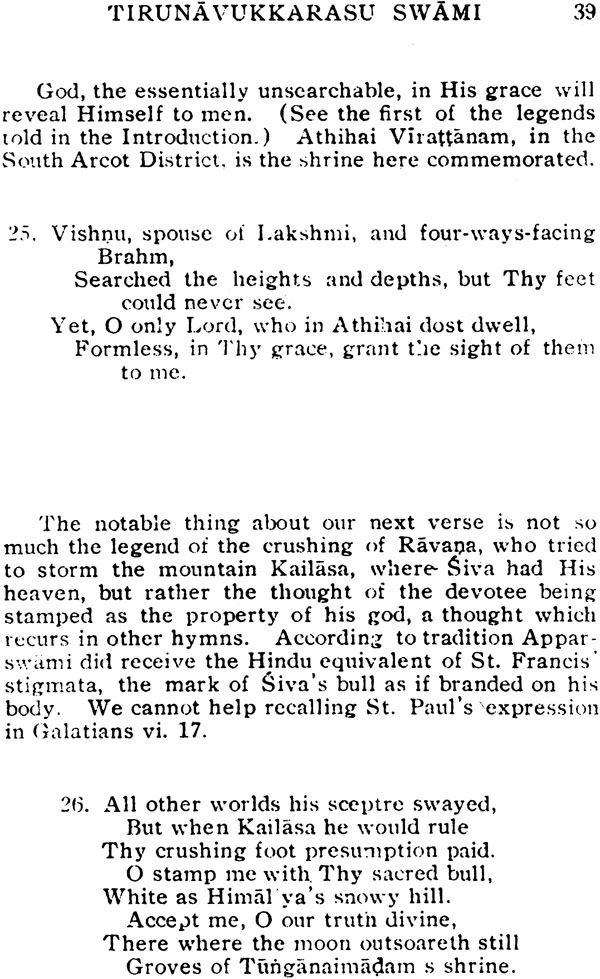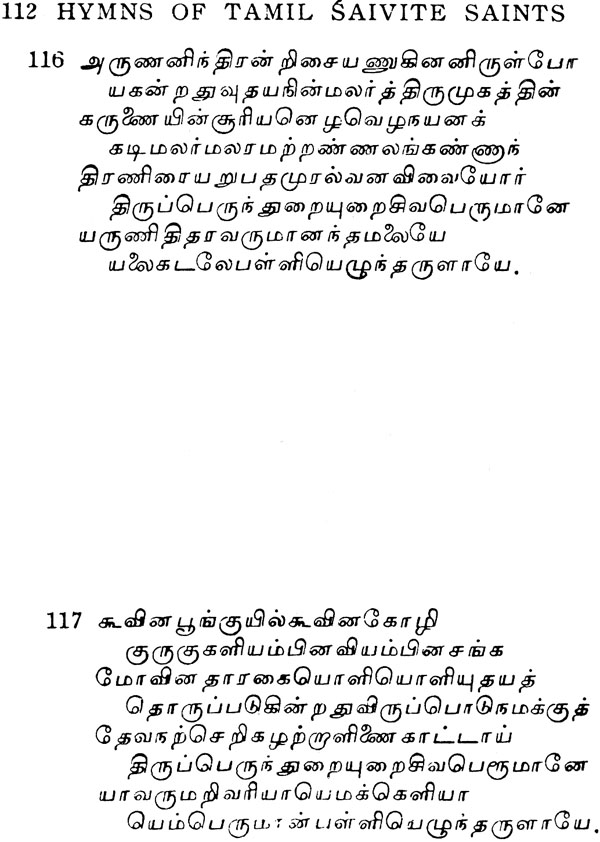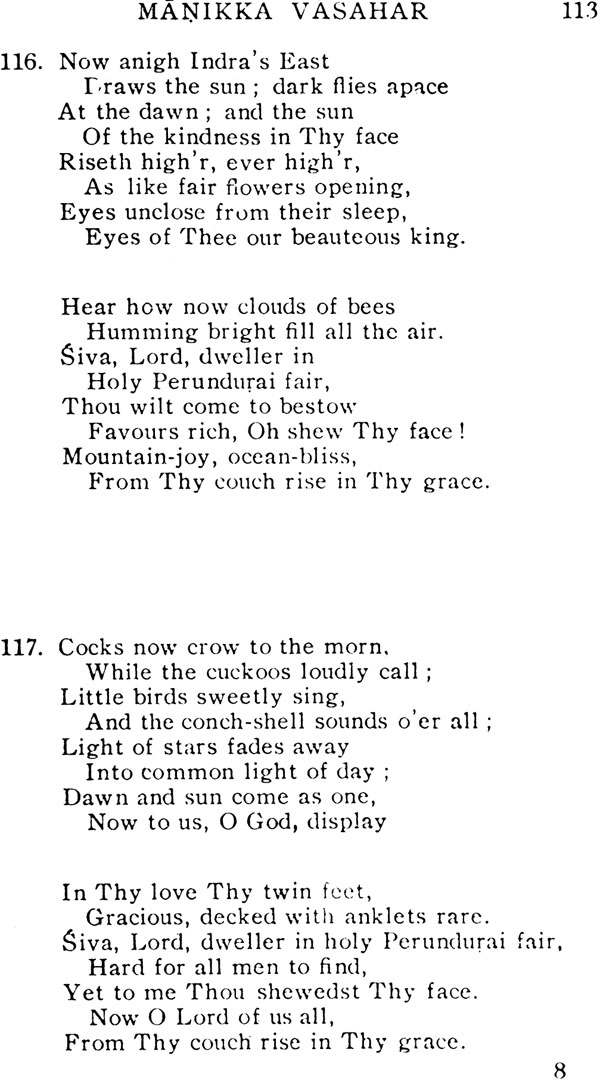
Hymns of the Tamil Saivite Saints
Book Specification
| Item Code: | IHL224 |
| Author: | F. KingsburyG.P. Phillips |
| Publisher: | Sri Satguru Publications |
| Language: | Tamil Text with English Translation |
| Edition: | 2000 |
| ISBN: | 8170301696 |
| Pages: | 138 (Five B/W Illustrations) |
| Cover: | Paperback |
| Other Details | 8.5 Inch X 5.5 Inch |
| Weight | 170 gm |
Book Description
The Hymns given in the book are specimens from the Devaram and the Tiruvacakam. The Devaram is the first of the collections of works held as canonical by Tamil Saivites. Its hymns were composed between six and eight hundred A.D. by the three authors of whom this book gives some account. The Tiruvavacam or Sacred literature was written by one author Manikya Vachaka. It stands even higher than the Devaram in the affection of the Tamil people. Out of enormous number of hymns, those are selected for translation which are most representative,, favourites and those which contains the most striking thoughts. The present book contains hymns of Sambandhar, Apparaswamy, Sundarmurti, and Manikya. There are two appendices – I. Shrines mentioned it the poems; 2. System of transliteration & pronunciations. An index is also given in the book.
(A) – The Hymns and their Significance
The voice of chanting and song, to the accompaniment of unfamiliar instruments, floats out over the high wall of the temple in the coolness of the evening or the dawn, making the Western passer – by wonder what it is that is being chanted and sung. If only he had a Hindu hymn – book he thinks he could learn from it the spirit of Hinduism as well as a non – Christian could learn Christianity from Christian hymns. For the Tamil country at any rate there is such a hymn book, and our present aim is to give enough specimens from it for readers to know what the hymns are like. Englishmen are wanting to understand India more than they ever wanted before, for their debt to India is heavy. Indians are wanting more than ever before to know the wonderful past of their own country and the wonder of it is all bound up with its religion. At such a time these hymns are worth looking into, for they are being sung in temples and homes throughout the Tamil country, and Tamil is the mother – tongue of more than eighteen millions of people. For pious Saivites they equal in authority the Sanskrit Vedas the mere learning of them by rote is held to be a virtue, and devout Tamil parents compel their children to memorize them in much the same way as Christian parents make their children learn the Psalms.
The hymns here given are specimens from the Devaram and the Tiruvachakam. The Devaram is the first of the collections of works held as canonical by Tamil Saivites. Its hymns were composed between six and eight hundred a.d. by the three authors of whom this book gives some account, and the whole was put together in one collection of 797 stanzas by Nambi Andar Nambi about 1000 A.D. The Tiruvachakam, or sacred Utterance, was written by one author, Manikya Vachaka (Tamilized as Manikka Vasahar) at a date so far unsettled that scholars are still divided on the question whether, it preceded or followed the Devaram, though most scholars place it in the ninth, or early in the tenth, century. Whenever it was written, it stands even higher than the Devaram in the affections of Tamil people.
Out of an immense number of hymns we have tried to select those which are most representative, those which are favourites, and those which contain the most striking thoughts. But it is amazingly difficult to give a fair or adequate idea of them in an English rendering. They are essentially songs, intended to be sung to Indian tunes, in metres which no English metre can represent. Much of their charm depends upon assonance, upon plays upon words, upon close knitting of word with word, upon intricacy of metre and rhyme, almost as much as upon the substance. We can only claim a fair degree of accuracy in our renderings, apologizing to the lovers of Tamil poetry for the plainness and poverty of our representation of so rich and varied an original. All our translations are new, and nearly all of those from the Devaram represent verses which have never before been done into English. One of the translators of this book learned as a Saivite child to love these hymns, and therefore is the authority in matters of interpretation, the Englishman being responsible for the form. We shall be quite satisfied if our translations serve to call attention to the poems, and are some day replaced by worthier renderings.
We have tried to reduce introductory matter to a minimum, only giving such information as is necessary to enable readers to understand the hymns and the allusions in them. But is entirely necessary to say something about the worship of Siva, and to give a few words of biography of each of the four authors from whose work this book contains extracts.
(B) – The Worship of Siva
1. Its history previous to these poems.
The word Siva occurs even in the Rig Veda, but there it is only in conjunction with Rudra. The joining together of these names provokes conjectures as to whether we have here an amalgamation of two earlier deities an Aryan and a Dravidian, but these need not detain us here, since clearly even at this early date Siva was an Aryan deity, identical with Rudra the storm – god, and father of the Maruts, storm –gods them selves. Rudra is a handsome god; he uses his thunderbolts chiefly for punishing evil – doers, and is on the whole a kindly being. The name Siva means auspicious, and must not be confused with the Tamil word for ‘red,’ although as it happens Rudra – Siva was a red being.
In the period of the Puranas, we find that Siva, instead of being one of a multitude of nature – deities, has risen to be one of the great tried, Brahma, Vishnu, and Siva, who are far above all gods. How the change has come about we have not yet the means of discovering. The function has changed as much as the person, Siva being now the destroyer as Brahma is the creator and Vishnu the preserver. The process of reduction in the number of the superior deities goes further, and Brahma falls practically into the background, leaving only Vishnu and Siva as Supreme Being for the worship of the people of India. By the time Hinduism penetrated southwards into the Tamil country, probably somewhere about 500 B.C., it had two main forms, the worship of Vishnu and the worship of Siva, the two being not too sharply disconnected. The Tamil Hindu believed in the existence of both, but held his own god, whether Siva or Vishnu, to be supreme. Hinduism seemed to be firmly established, but was dangerously shaken when the Jains and Buddhists spread over South India. Then came for the Vaishnavites the teachers known as the Alvars, while Saivism was defended by the poets of whose work this book gives specimens. Hinduism was saved, but it existed henceforth in two distinct forms, Vaishnavism and Saivism, separated by a wider gulf than in earlier days.
| Introduction | 1 | |
| I. | Sambandar and his Hymns – Stanzas 1-24 | 10 |
| II. | Apparswami and his Hymns – Stanzas 25-64 | 35 |
| III. | Sundaramurti and his Hymns – Stanzas 65-79 | 70 |
| IV. | Manikka Vasahar and his Hymns - Stanzas 80-136 | 84 |
| Appendix I: | Shrines Mentioned in the Poems | 128 |
| Appendix II: | System of Transliteration and Pronunciation | 129 |
| Index | 131 |









